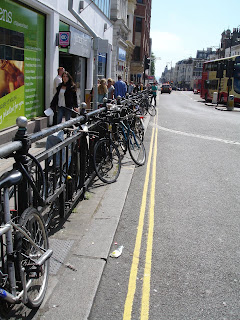 |
| Could Brighton & Hove's CTS look like this example? Many Continental and USA cities use Bus Rapid Transit (BRT) systems with standard buses, light-rail like stations, queue jumpers, priority traffic lanes and signals. Stations at one-mile intervals. |
26 July 2011. A rapid transit public transport scheme could become reality in Brighton and Hove as early as later this year, according to Brighton and Hove City Council's Air Quality Action Plan (AQAP) 2011.
*** Update: 27 July 2011. A council source commented today: "The CTS proposal was made in a previous era when there was money around for such schemes, alas, whilst it remains an aspiration, the funding is no longer in place for this."
The AQAP report issued last week says the Coastal Transport System (CTS) (formerly known as Rapid Transport System (RTS)) could begin in 2011/12 "subject to acceptance of the Business Case by the Government".
If approved, the express, limited-stop-route would run from Brighton Marina in the East, via the Royal Sussex Hospital and Brighton Station, then along the Kingsway to the King Alfred, and finally to Shoreham Harbour in the West. CTS could connect with other public transport links. This would hugely speed up journey times for those using public transport along these routes.
The report says: "The CTS is designed to create a step change in public transport services and infrastructure in Brighton & Hove by providing an attractive, alternative for some journeys to reach both existing and future planned destinations. This will provide sufficient choice for some car drivers and assist in contributing towards transport modal shift that is in line with the council’s LDF Core Strategy. CTS aims to deliver a socially inclusive transport mode. The increased capacity of the public transport network will offer environmental and economic benefits to the city.
CTS would initially link key social, leisure, residential, business and employment destinations between Worthing (West), Brighton Marina (East) and Brighton Station (City Centre). Utilising a high quality, frequent express with limited stops, the CTS will complement, rather than compete with, existing local bus and train services.
The CTS is propsed to use two key corridors (east and west) with segregated priority on the route and at junctions where possible. The route will be :
• East out of Brighton Station – North Street – Eastern Road – Royal Sussex Hospital – Brighton Marina.
• West out of Brighton Station – West Street – Kings Road – King Alfred Centre - Shoreham Harbour
The routes will link the railway station, the retail centre, major businesses such as American Express, the Royal Sussex County Hospital and visitor destinations such as the Marina and the seafront.
CTS is based on the concept of high frequency, limited stop services to primarily meet the needs of passengers who otherwise may not have considered conventional local Brighton and Hove City Council – England July 2011 bus services. It is expected that there will be 10 RTS stops in Brighton & Hove.
Proposed CTS stops:
• Brighton Station – a key interchange for longer distance passengers seeking links to American Express, Hospital, Marina or Shoreham Harbour developments – the number and type of buses and taxis needs to be managed at this interchange from an air quality point of view
• Clock Tower – access to Churchill Square and other central retail areas in Brighton centre although the number of buses at this junction must be managed with a view to the air quality implications
• North Street – access to the Cultural Quarter, tourist, retail and employment areas, plus bus to bus interchange, North Street has between 3,500 and 4,000 buses a day
• American Express (Edward Street) – serving one of the city’s major employers
• Royal Sussex County Hospital (Eastern Road) – a key sub-regional health facility
• Brighton Marina – a significant leisure destination and retail destination , as well as serving major residential development and the proposed Brighton International Arena
• Brighton Conference Centre – gives access to the Brighton seafront as well as an important destination
• Hove Seafront – offering an intermediary stop serving residential and employment uses, as well as offering a tourist link
• King Alfred Centre – a potential redevelopment site
• Shoreham Harbour – significant regeneration potential for residential, commercial, leisure and community uses.
*** UPDATE 27 July 2011: In the notes to the AQAP report, the CTS Rapid Transport System is mentioned as an option to the Local Transport Plan (2) which was the plan for the period 2000-2011, and now succeeded by LTP3. The notes say the Rapid Transport System was to have been implemented by BHCC and Brighton and Hove Bus Co. It was rated as having "HIGH" impact on air quality. The budget cost was £11.4m mainly for planning a priority route for express buses. Other benefits were to reduce impact of private car use resulting in less noise, congestion and improved road safety. "Targeted at specific road network but will also reduce private vehicle traffic citywide".
Intriguingly, the notes say that the Rapid Transport System was to have been implemented in 2008-2009. There's obviously some discrepancy here with the main text of AQAP, which says the CTS project would be implemented in 2010-11.
It seems this Rapid Bus scheme was left over from the original Local Transport Plan of 2000. Other parts of this sustainable transport plan (such as Old Shoreham Road) fell victim to the policies of the Tory administration in the years 2007-2011, which, apart from relentless cost saving, also attempted to "repeal" the council's commitment to sustainable transport - because it "
unfairly penalised" car drivers.
For more analysis of the AQAP 2011 report: click here.


















